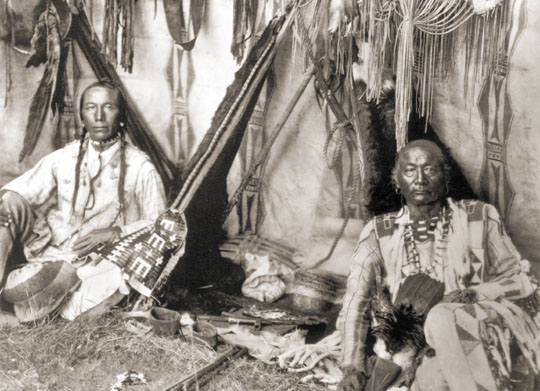 Edward S. Curtis:
Selections from The North American Indian Portfolio
Edward S. Curtis:
Selections from The North American Indian Portfolio Edward S. Curtis:
Selections from The North American Indian Portfolio
Edward S. Curtis:
Selections from The North American Indian Portfolio
Curtis’ photographs are suffused with nostalgia for the vast frontier of the American West, which he and his contemporaries knew would soon vanish. He wrote in his introduction to the study: "The passing of every old man or woman means the passing of some tradition, some knowledge of sacred rites possessed by no other; consequently the information that is to be gathered...respecting the mode of life of one of the great races of mankind, must be collected at once or the opportunity will be lost for all time."
Curtis has been criticized for romanticizing an idealized Indian way of life, while ignoring the very real plight of the native tribes he went to photograph. In fact, he was an outspoken critic of government policies, which by this time had forced Indians to relinquish vast tracts and restricted them to reservations. It is true that Curtis posed his subjects in archaic or ceremonial garments they did not ordinarily wear, and supplied wigs to disguise 20th-century haircuts. He also photographed his subjects in activities they no longer practiced, as warriors for example. He excluded or removed details from his photographs that betrayed evidence of acculturation, and retouched his negatives to make his prints more aesthetically appealing. Despite these devices, Curtis’ works give us a glimpse, however fleeting, of the heroes of Indian resistance, such as of the Lakota (Sioux) chief, Red Cloud, or of the aged Hopi potter who continues her traditional way of life in the face of great change.
The photographs in this exhibition are drawn from the complete set of The North American Indian housed in the William R. Oliver Special Collections Room at the Carnegie Library. The exhibition focuses on the tribes of three cultural areas: the Southwest -- Navajo, Apache, Pima, Hopi and Zuni; the Plains -- Ogalala Sioux, Crow, Blackfeet and Cheyenne; and Northwest Coast -- Coast Salish, Kwakwak‡wakw (Kwakiutl) and Nuuchahnulth (Nootka).
Linda Batis is associate curator of Fine Arts, Carnegie Museum of Art.
Contents |
Highlights |
Calendar |
Back Issues |
Museums |